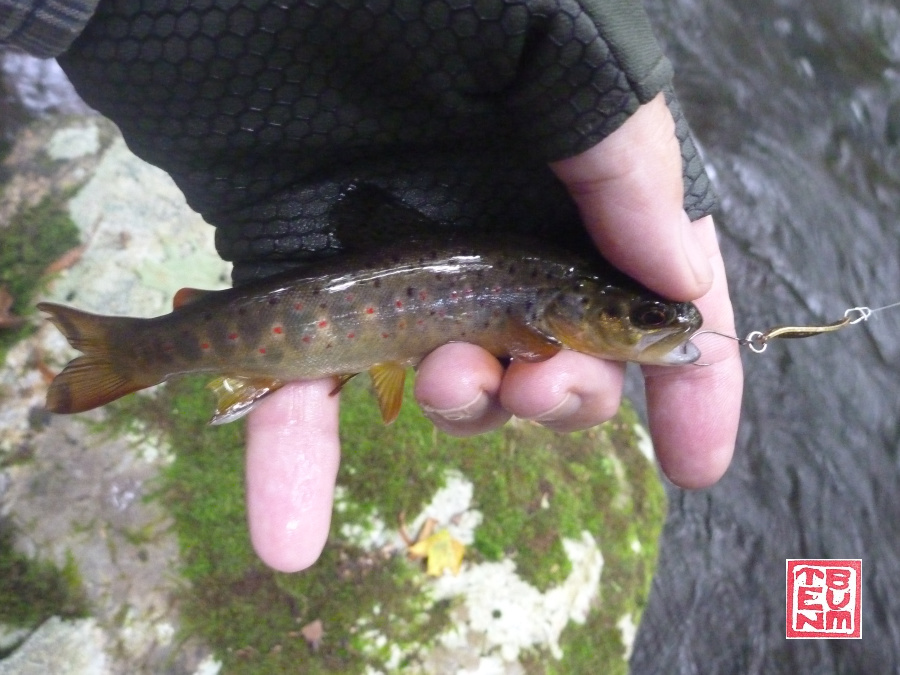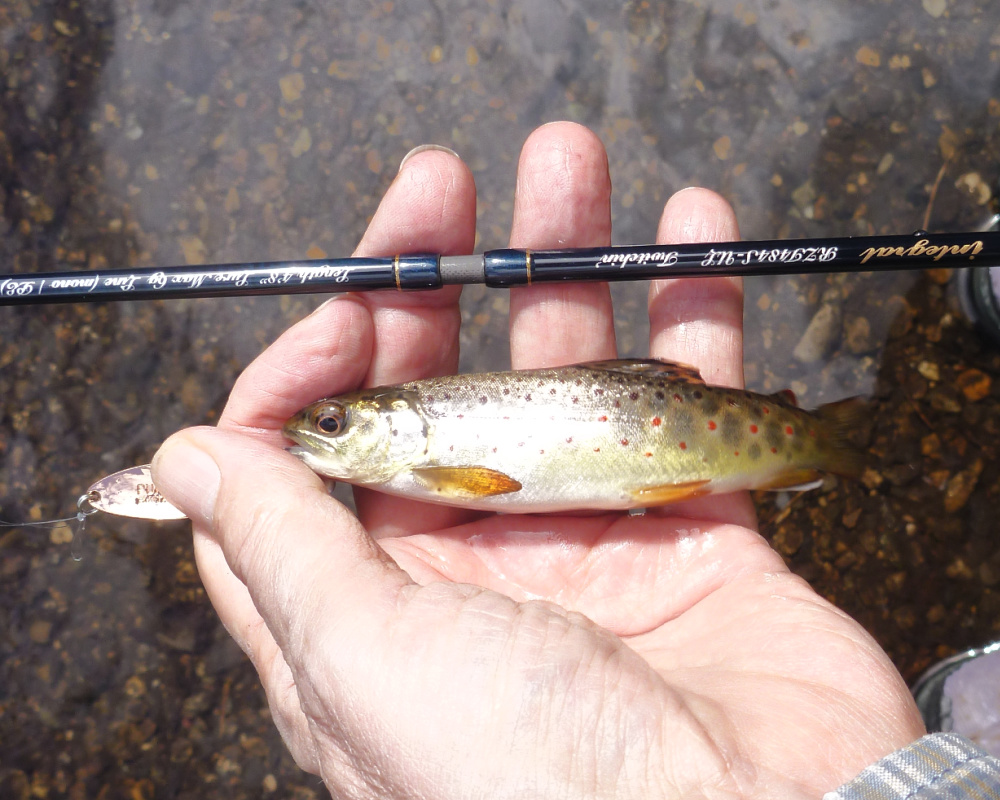Micro Spoons
Micro Spoons are surprisingly effective for trout and panfish (both sunfish and crappies). I have caught bass, fallfish and creek chubs with them as well. If you haven't yet tried them, get some. I think you will be very pleasantly surprised.
There is no definitive industry standard for what would be considered a "micro spoon." I know of one company that calls their 1/8 oz spoons "micro spoons." Most of the spoons I have sold here on Finesse-Fishing.com were 1/8 oz or less, so most would be micro spoons under that definition. One eighth ounce is about 3.5 grams. I've never considered the 3.5, or 3, or even most of the 2.5 gram spoons I sold to be micro spoons. I'd always thought micro spoons were smaller.
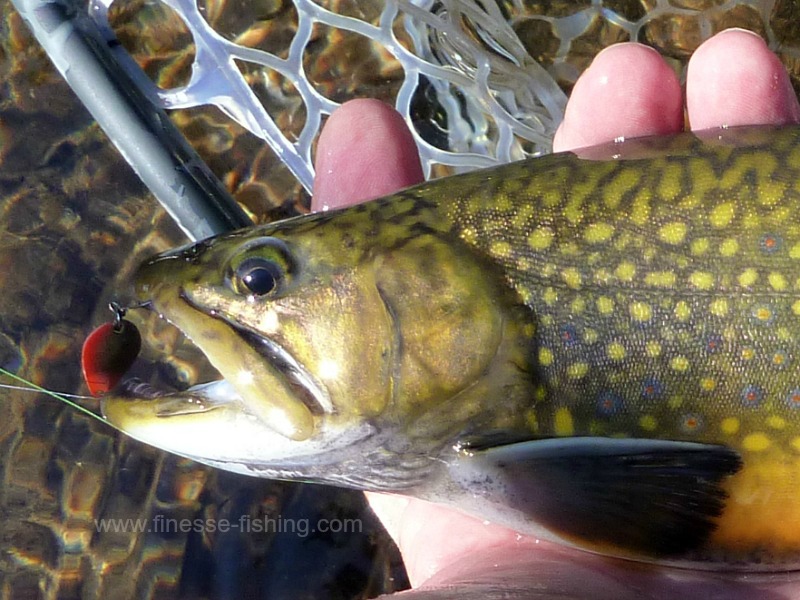 Nice brookie caught with .8g (1/35th oz) spoon
Nice brookie caught with .8g (1/35th oz) spoonPersonally, I would have chosen 1/16 oz (about 1.8 grams) rather than 1/8 oz as the upper weight limit for a micro spoon. The 1/8 oz spoons are extremely productive for trout, but so are much smaller spoons. I have found spoons of 1/16 oz or less to be just as effective for trout and a lot more effective for crappies and sunfish. For sunfish in particular, smaller is better.
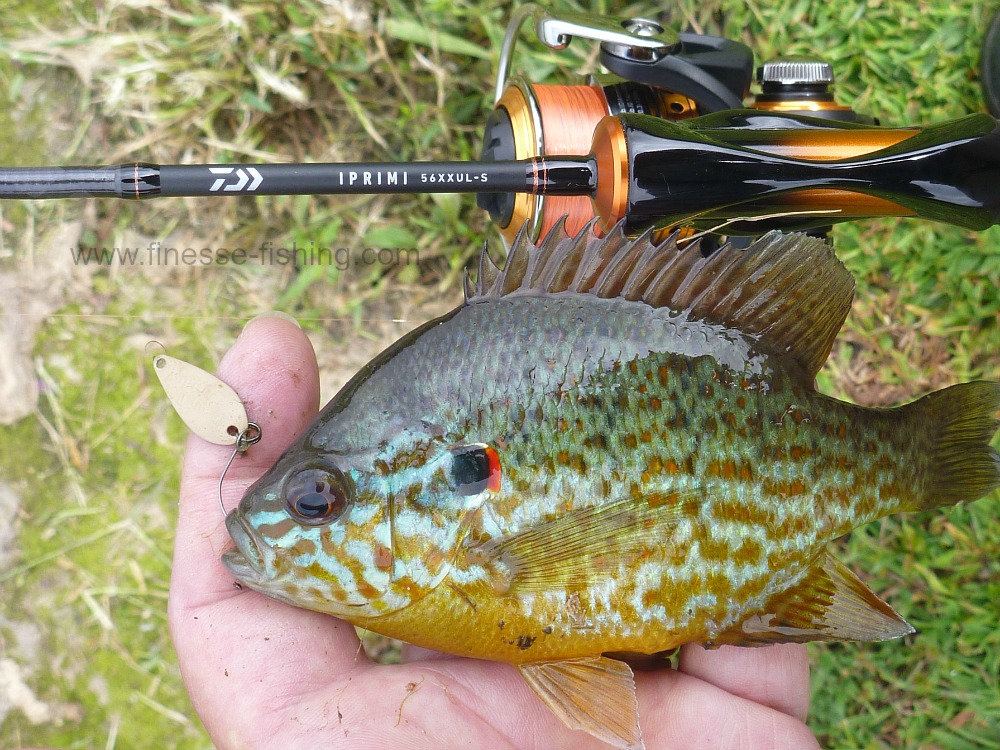 Pumpkinseed caught with .8g spoon
Pumpkinseed caught with .8g spoonThere aren't many spoons that weigh just 1/16 oz in the US, but they are common in Japan, where micro spoons are the most popular lure for fishing in Areas (private pay-to-fish lakes). Although we have pay-to-fish trout parks and trout preserves in the US, they aren't common and I don't think they're that popular (other than perhaps the trout parks in Missouri, which doesn't have much trout water). In Japan, though, they are quite popular. There are dedicated anglers - and dedicated equipment that can run up to $800 for a rod. By the way, a 1/8 oz spoon is over the recommended lure weight for that $800 rod.
Even in Japan, where micro spoons are very popular, there is no universally accepted definition of a micro spoon. I have seen one blog post that suggested any spoon under 2 grams is a micro spoon. I have seen more, though, that define a micro spoon as being no heavier than 1 gram. A one gram spoon is certainly micro, but micro needs to be within the context of the spoons that are generally used and the spoons that are generally available.
Here in the US the 1 gram limit is too low. Perhaps if small spoons become a lot more popular here it would make sense to divide them into those that weigh less than a gram and those that weigh more than a gram but we're not there yet. Although I had initially chosen 1/16 oz (about 1.8 grams) as the upper limit for the purposes of this website, upon reflection I think I can accept the 2 gram limit to call a spoon a micro spoon.
However, there are several small spoons in Japan that come in a variety of weights, with the different weights coming from the spoon being stamped out of metal sheets of different thicknesses. It would make no sense for some to be considered micro and some not when they share the same length and width, varying only in the thickness of the metal.
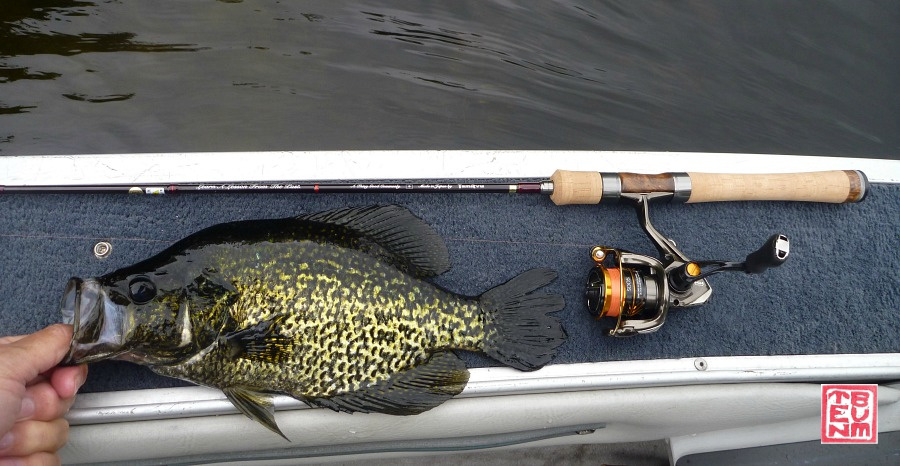 Tenryu Rayz Alter RZA61L-T and black crappie
Tenryu Rayz Alter RZA61L-T and black crappieThe lightest spoons I've seen weighed .4g. You can't cast a .4g spoon very far, but you can cast it far enough to catch fish. For quite some time, the Daiwa Presso Vega .4g spoons were offered on this site and on the TenkaraBum.com site. Lots of people caught lots of fish with them.
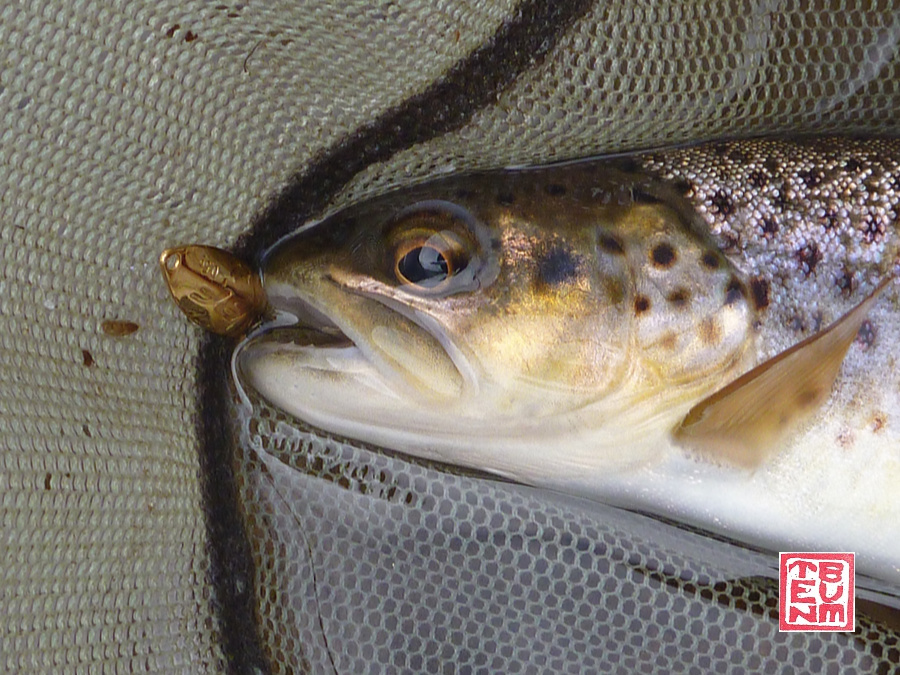 Rodio-craft Blinde Flanker .5g gold spoon
Rodio-craft Blinde Flanker .5g gold spoonAll good things must end, and Daiwa discontinued the Vega spoons. I then found a .5g spoon, the Rodio-craft Blinde Flanker, which I thought was even better. They are a little smaller than the Vega spoons but they are thicker and they weigh 25% more. They cast just as nicely with tenkara rods (and fly rods). Because they are both heavier and smaller, they get a bit deeper.
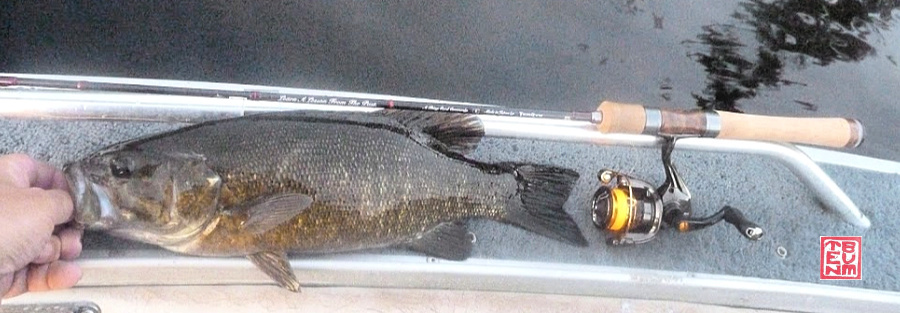 Eighteen inch smallmouth caught on .9g spoon.
Eighteen inch smallmouth caught on .9g spoon.Every year, a friend and I vacation in Maine to fish for smallmouth bass. Most of the fish we catch are 14-17". We don't usually fish micro spoons. A few years ago I spent some time fishing with my Tenryu Rayz Alter RZA61L-T (Tenryu has since changed their rod naming system, and that rod is now called the RZA612-LT), which is a great rod for catching modest fish. I was having a wonderful time catching the little 8-9" smallies that are common around the rocky shoreline of the lake we fish, using a .9g spoon. Running the boat just a little way offshore, I was casting for accuracy, not for distance. All was going according to plan until I cast to a rock pile in the middle of a cove and hooked this 18 incher. The soft Area trout rod took a while to subdue the beast. Patience and a reel with a good drag allow you to land nice fish, though.
Everyone thinks "big bait, big fish" but big fish eat small things, too! If you present a big fish with an easy meal, it's likely to take it. For that matter, small fish will hit big baits, or at least lures that they couldn't possibly swallow.
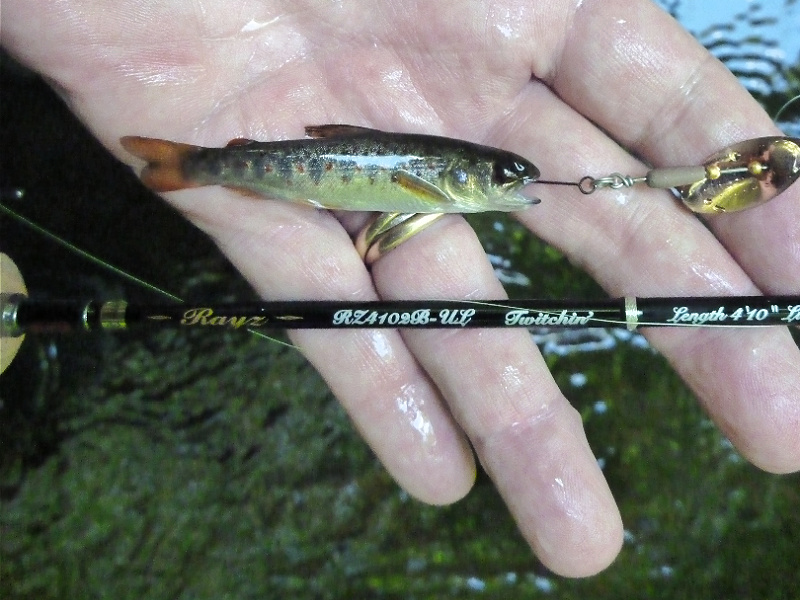 Yes, it's a spinner but the concept is the same.
Yes, it's a spinner but the concept is the same.The only times I've felt I needed really small micro spoons were when fishing for sunfish, which have small mouths, and when fishing for micros.
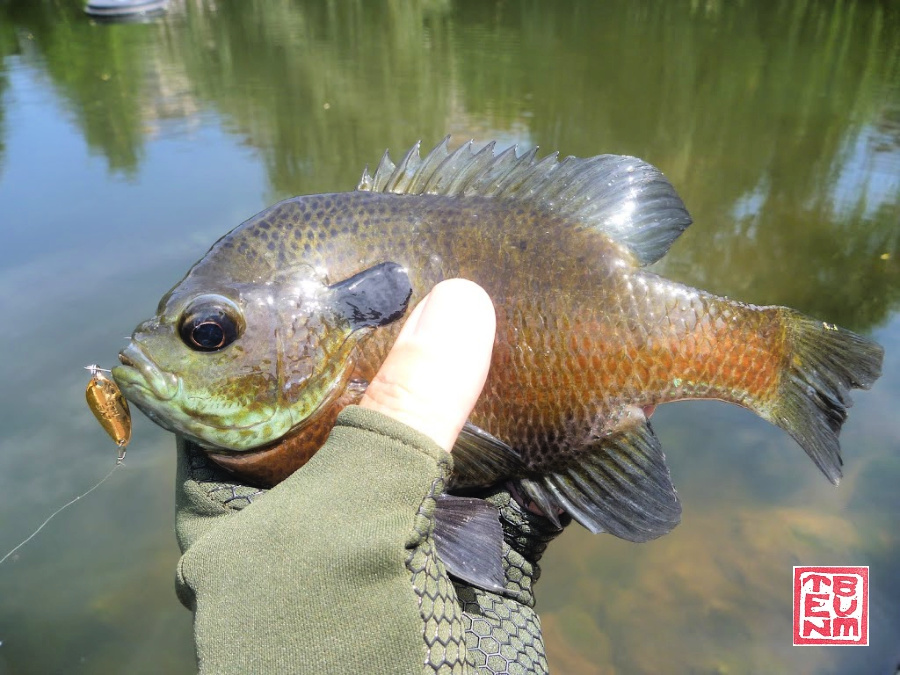 Daiwa Presso Eve 1.2g gold spoon
Daiwa Presso Eve 1.2g gold spoonThe Daiwa Presso Eve 1.2g spoons are heavy enough to cast well with any of the UL spinning rods that are offered on Finesse-Fishing.com. The Eve spoons are less than an inch long - plenty small enough for bluegills
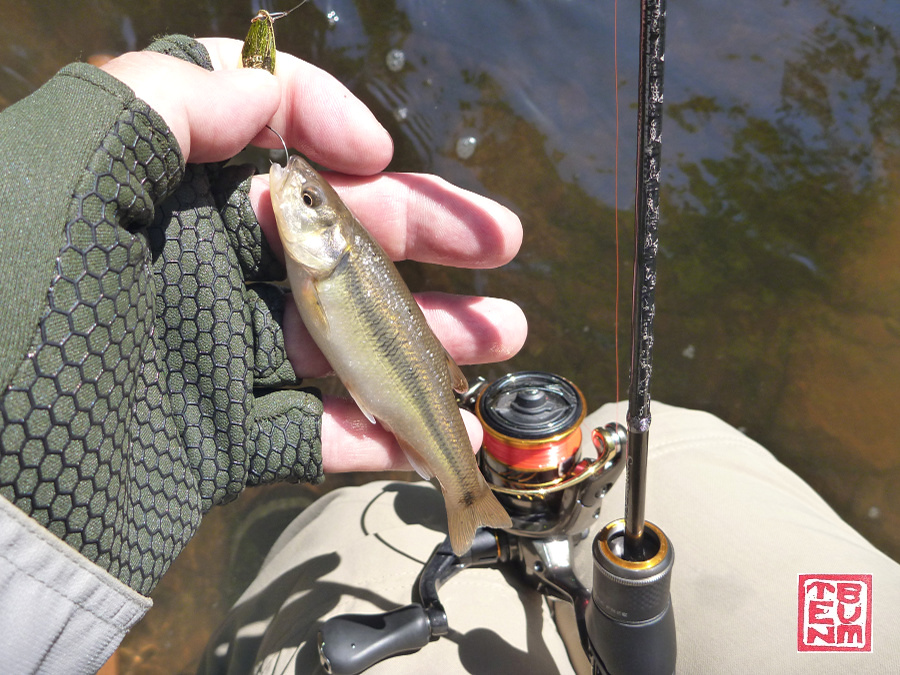 Creek chubs will hit the Daiwa Presso Eve 1.2g spoons.
Creek chubs will hit the Daiwa Presso Eve 1.2g spoons.Micro spoons are small enough for micro fish! Not all micros by any means, but creek chubs will hit micro spoons given half a chance.
Shimano's Slim Swimmer spoons are narrower for their length than most spoons. That makes them closer to the shape of most minnows. I have found them to be very effective. I believe the 1.5g Slim Swimmer is small enough to do be very effective for both sunfish and creek chubs. (I know, no one fishes for creek chubs, but perhaps you should. They're found from Maine to Montana, and Ontario to Alabama, and they're in the little creeks that no one else fishes!)
The Smith Pure 2g copper spoon shown above is heavy enough that an ultralight spinning rod can cast it as far as you'd need to cast on any small stream. For that matter, casting a 2g spoon is well within the capability of the Tenryu Rayz Integral RZI484B-UL or the Rayz RZ4102B-UL.
Although micro spoons are the most popular lure for fishing the Areas in Japan, they are also effective for fishing in streams, with two caveats: 1) they are light weight, so they do not get very deep. 2) if you fish downstream, the current will force them to the surface. I have done very nicely with them in smaller streams that do not have fast current. Casting upstream has worked, and casting up-and-across into little bank eddies has worked extremely well.
It was an eye-opener to see a Japanese YouTube video of a guy fishing micro spoons in a mountain stream with an extra ultralight rod designed for fishing in Areas. It was a very soft rod, and would not have done well with the heavy sinking minnows most steam anglers use in Japan. With the micro spoons, though, it actually worked very nicely.
To get the best action, attach the spoon to your line with a nonslip loop knot, a snap or a split ring. Don't use the common snap swivels available in the US. They are too large, too heavy, and will ruin the action.
The only spoons that I have in stock that could be considered micro spoons are the 1.5g Shimano Slim Swimmer spoons.
Finesse-Fishing Home > Single Hook Lures > Micro Spoons
Header photo: Tenryu Rayz RZ4102B-UL, Shimano Calcutta Conquest BFS-HG ('17)
Warning:
The hooks are sharp.
The coffee's hot.
The fish are slippery when wet.
Seriously, all the hooks sold on Finesse-Fishing.com, whether packaged as loose hooks or attached to lures, are dangerously sharp. Some have barbs, which make removal from skin, eyes or clothing difficult. Wear eye protection. Wear a broad-brimmed hat. If you fish with or around children, bend down all hook barbs and make sure the children wear eye protection and broad-brimmed hats. Be aware of your back cast so no one gets hooked.
Also, all the rods sold on Finesse-Fishing.com will conduct electricity. Do not, under any circumstances, fish during a thunder storm. Consider any fishing rod to be a lightning rod! Fishing rods can and do get hit by lightning!
Whatever you do, do it with finesse!
